【上海教育版】英语三年级上册:Unit2《The four seasons》公开课【一等奖教案】(Word版)
- 格式:doc
- 大小:86.50 KB
- 文档页数:10
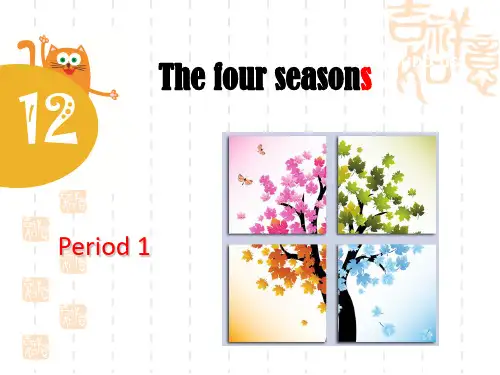
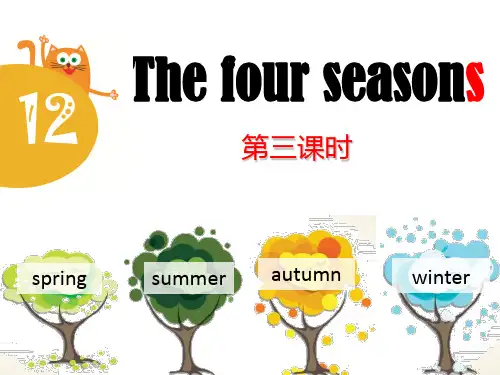
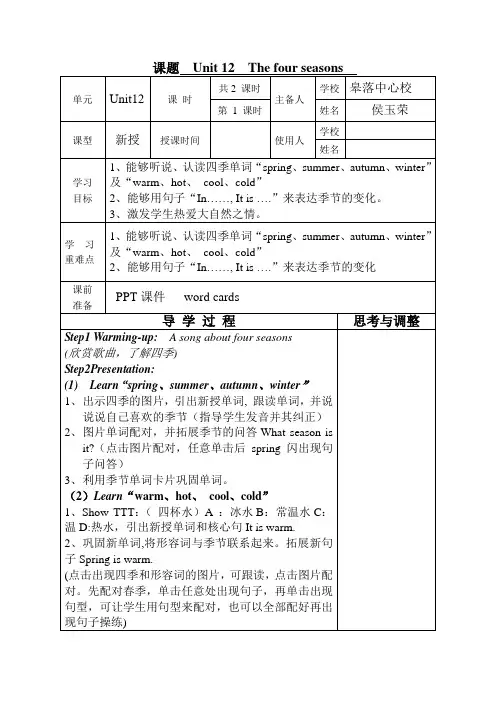
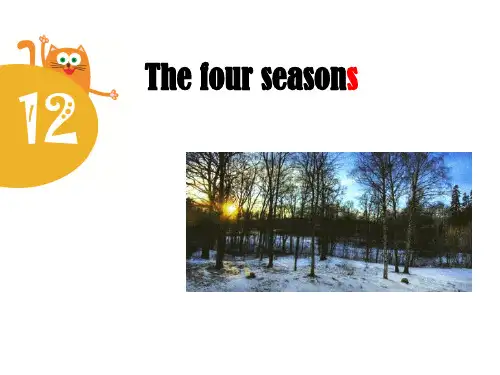
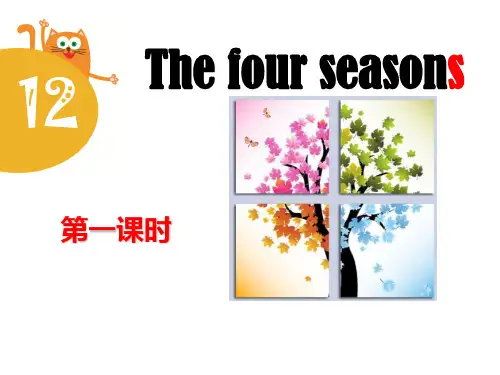
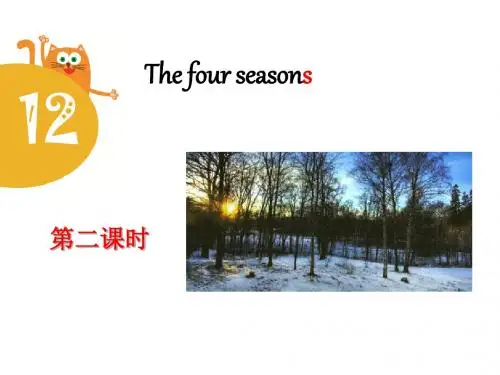
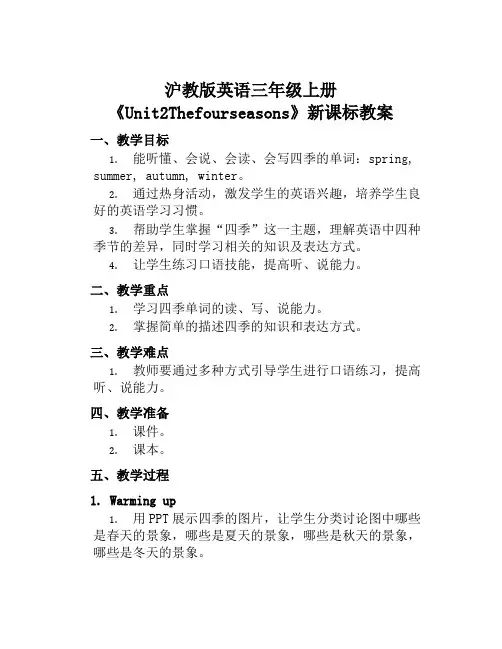
沪教版英语三年级上册《Unit2Thefourseasons》新课标教案一、教学目标1.能听懂、会说、会读、会写四季的单词:spring, summer, autumn, winter。
2.通过热身活动,激发学生的英语兴趣,培养学生良好的英语学习习惯。
3.帮助学生掌握“四季”这一主题,理解英语中四种季节的差异,同时学习相关的知识及表达方式。
4.让学生练习口语技能,提高听、说能力。
二、教学重点1.学习四季单词的读、写、说能力。
2.掌握简单的描述四季的知识和表达方式。
三、教学难点1.教师要通过多种方式引导学生进行口语练习,提高听、说能力。
四、教学准备1.课件。
2.课本。
五、教学过程1. Warming up1.用PPT展示四季的图片,让学生分类讨论图中哪些是春天的景象,哪些是夏天的景象,哪些是秋天的景象,哪些是冬天的景象。
2.做四季主题歌曲的动作,并学唱“Four Seasons Song”。
2. Pre-Task1.教师出示四季的相关图片,让学生在课桌前认读和背诵每个单词,并画一个与单词相符的图。
2.学生自主选择一张这个四季的图片,描述图片所表达的季节和特点,展现出学生的口语表达能力。
教师给予准确的反馈和指导。
3. While-Task1.向学生展示课本,让学生跟读和朗读课文中有关四季的句子,帮助学生掌握单词的正确发音和语序。
2.学生分组完成四季卡片的制作,一个小组一个季节;每个小组展示自己的季节卡片,并在课前布置的“四季印象”模板上写下自己对这个季节的主要印象,让学生对于每一个季节有一定的理解。
3.在学习完四门季节的单词之后,老师展示季节变化的图片,带着学生依次描述每一张图片,并询问季节的变化有哪些。
通过这种方式提高学生的口语表达能力。
4. Post-Task1.学生回顾自己对于每一个季节的“印象”,利用这些简单的语言进行口语练习。
2.教师鼓励学生自由发挥,用英文描绘自己最喜欢的季节,可以借助PPT或者其他多媒体工具展示自己的想法。
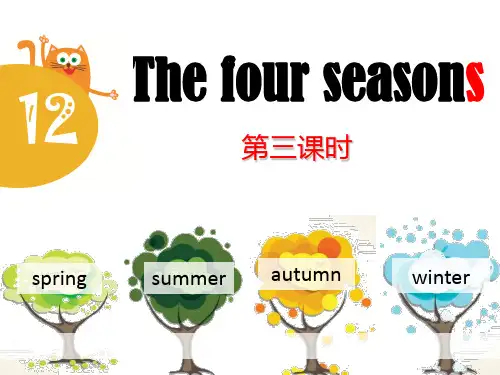
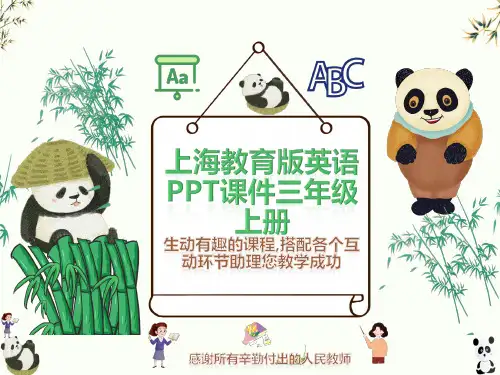
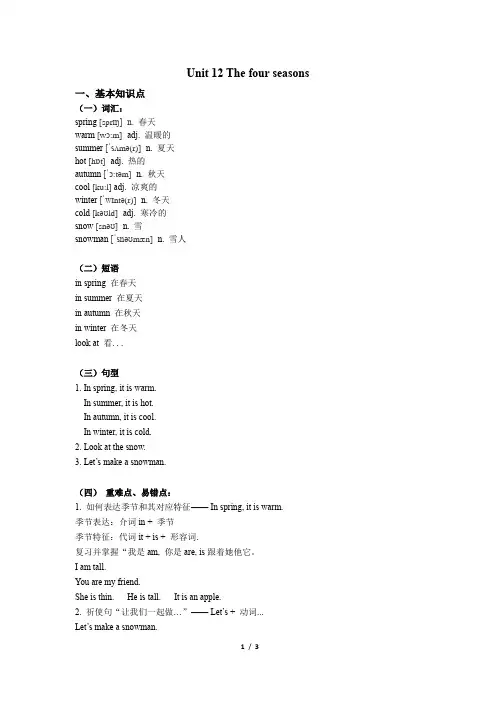
Unit 12 The four seasons 一、基本知识点(一)词汇:spring [sprɪŋ]n. 春天warm [wɔ:m]adj. 温暖的summer [ˈsʌmə(r)]n. 夏天hot [hɒt]adj. 热的autumn [ˈɔ:təm]n. 秋天cool [ku:l]adj. 凉爽的winter[ˈwɪntə(r)]n. 冬天cold [kəʊld]adj. 寒冷的snow[snəʊ]n. 雪snowman [ˈsnəʊmæn]n. 雪人(二)短语in spring 在春天in summer 在夏天in autumn 在秋天in winter 在冬天look at 看...(三)句型1. In spring, it is warm.In summer, it is hot.In autumn, it is cool.In winter, it is cold.2. Look at the snow.3. Let’s make a snowman.(四)重难点、易错点:1. 如何表达季节和其对应特征—— In spring, it is warm.季节表达:介词in + 季节季节特征:代词it + is + 形容词.复习并掌握“我是am, 你是are, is跟着她他它。
I am tall.You are my friend.She is thin. He is tall. It is an apple.2. 祈使句“让我们一起做…”—— Let’s + 动词...Let’s make a snowman.1/ 3Let’s look at the picture.二、典型例题1. I can make a snowman in ______.A.springB. winterC. autumn【解析】答案:B. 根据句意,“我可以制作一个雪人在…”可知雪人在冬天,所以选择B。
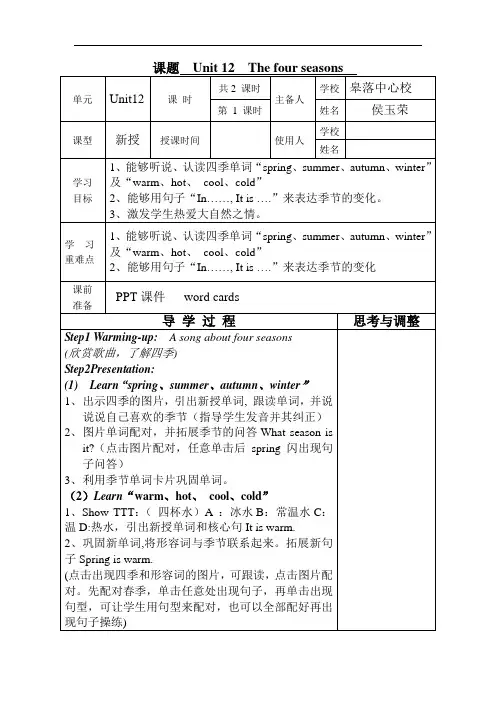
沪教2011课标版三年级起点三年级上册《2Thefourseasons》教案及教学反思一、教案设计1. 教学目标•能够听、说、读、写单词和课文中的句子•了解四季的不同特点和活动•能够用英语表述四季的活动和感受2. 教学重难点•重点:四季的活动和感受的表达•难点:不同季节之间的对比3. 教学内容•单词:spring, summer, autumn, winter, sunny, windy, rny, snowy•句型:What’s the weather like? It’ssunny/windy/rny/snowy.•课文:2 The four seasons4. 教学步骤(1) Warm-upT: Good morning, boys and girls! How are you today? Ss: Good morning, teacher! We are fine, thank you. T: What’s the weather like in Shangh today?Ss: It’s sunny/windy/rny/snowy.T: Great! To day we’re going to talk about the four seasons. Can you name the four seasons in English?Ss: Yes, they are spring, summer, autumn, and winter.T: Very good. What do you like to do in each season?(2) PresentationT: Now let’s look at some pictures and talk about the weather and activities in each season.(Show pictures of spring, summer, autumn, andwinter on the board.)T: What’s the weather like in spring?Ss: It’s sunny and rny.T: Yes, that’s right. What do you like to do in spring?Ss: We like to fly kites and have a picnic.T: Good. And what’s the weather like in summer?Ss: It’s hot and sunny.T: Yes, that’s right. What do you like to do in summer?Ss: We like to swim and eat ice cream.T: Great. And what’s the weather like in autumn?Ss: It’s coo l and windy.T: Yes, that’s right. What do you like to do in autumn?Ss: We like to pick apples and go hiking.T: Excellent. And what’s the weather like in winter?Ss: It’s cold and snowy.T: Yes, that’s right. What do you like to do in winter?Ss: We like to make a snowman and drink hot chocolate.(3) PracticeT: Now let’s practice the sentence pattern:What’s the weather like? It’s sunny/windy/rny/snowy. Let’s start with sunny. (Model the sentence pattern and have the students repeat.)T: What’s the weath er like today?S: It’s sunny.T: Great. What’s the weather like in autumn?S: It’s windy.T: Excellent.T: Now let’s practice reading the text。